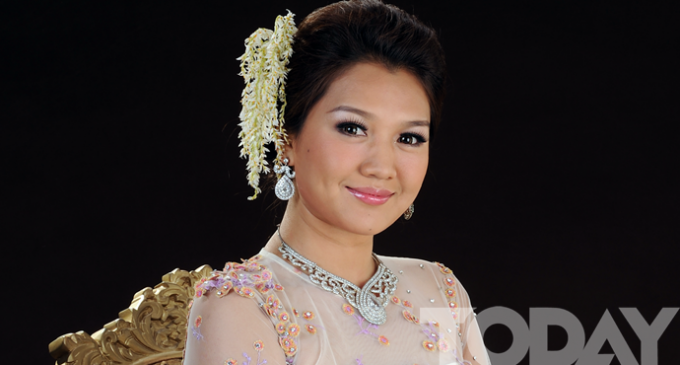Flora in myanmar culture : thazin

Nataw the 9th month of Myanmar lunar calendar corresponds to December. It is the second month of Myanmar cold season called Heyman of four months Tazaungmon, Nataw, Pyatho and Tabo Dwe; November, December, January and February respectively. In cold season, Myanmar wild flowers especially orchids bloom profusely bearing a variety of hues and fragrances.
Among Myanmar orchids of the wild, Thazin (Bulbophyllum ouvicomum) is the most coveted and appreciated flower of Myanmar peoples. Originally spelt and pronounced Thant-sin meaning clean and pure flower because it grows on branches of high trees in the forest in Winter, November, December and January. When the sky and environment are free of five kinds of pollution namely (1) snow (2) fog (3) mist (4) solar mirage and (5) smoke. Thazin is traditionally designated as flower of the month of Nataw.
Thazin blooms are tiny yellowish flowers on a tender shoot, only one from each yellow green egg shaped bulb that grows on the barks of trees. Graceful shoots laden with small blooms hang down like little pearly strings. Myanmar women have the flair for hairstyle since the olden days. In the long Bagan Period of over 3 centuries it was recorded in literature and mural paintings 55 different styles of women’s coiffures, let alone other hair styles of later historic periods including modern times. Graceful Thazin shoots simply fit any hairdo of any time. Besides, Thazin blooms bear an elegant fragrance–not too strong and not soft but just enough refreshing scent to the wearer and all round.
Thazin flower was listed among the royal flowers in the days of Myanmar monarchy. Only after the first pick of Thazin was offered to the Buddha and the royal family had used, Thazin flowers were allowed for commoners.
Myanmar literature has many references to and descriptions about this high-class flower. To give but one most prominent example was a love song of late Konbaung Period (1782-1885 A.D.) composed by Princess Hlaing Hteik Khaung Tin, the queen of Crown Prince Kanaung. She was a faithful lover and wife of crown Prince. But crown Prince was not a lover. He was a philanderer, enjoyed having affairs with pretty ladies. So she composed Bawlei songs express-ing her deep emotion of a forlorn lover. In the following two stanzas of her Bawlei song appear Thazin flower.
စိန္ျခဴးၾကာေညာင္
လေရာင္ေတြ လင္းပါေပါ့
မွန္ျဖဴျပတင္းရယ္က
မယ္ခုေမွ်ာ္၊ သံုးခ်က္စည္ေတာ္
႐ုိက္ေဆာ္ညွင္းတယ္ေလး
လင္းလုေပါ့ေနာ္။
သဇင္သင္းပါတဲ့
ခင္းျပန္႔ေပၚ
လာႏုိးငယ္မယ္ေမွ်ာ္လုိ႔
တကုိယ္ေတာ္ထူး၊
ေထြရာစိတ္ကူးပါလုိ႔
ဖူးေရႊလယ္တင္၊
ျဖစ္ေရွးကုန္စင္
ဘ၀င္တံု ေဆြးတယ္ေလး
ေတြးႀကံလုိက္ရင္၊
The moon sheds silvery light
On my gilt carved couch bright
At the white glass window
I sat upright,
Neglected, forlorn, waiting
through the night
For the arrival of you, my
darling dear,
Now Bahosi clock Drum
Strikes ‘3’ hour
And the dawn is
approaching so near.
But you’ve not shown up,
Why, I fear.
On the Thazin scented bed stead,
I lie awake, no sleep but
stray thoughts instead
With my frail hand placed on forehead
Fond memories of the past rolling back
Heart felt feelings in me fill to the neck.
In the first stanza Thazin is depicted in the gilt carvings of the couch. In the second stanza, Thazin is presented on the hair knot of the Princess and the velvet cover of her couch.
Though Myanmar women are very up-to- date in their fashion of dress and hair style, they still maintain their traditional costumes and hairdos.
Observe ear-boring ceremony of a Myanmar girl, as wedding of a Myanmar bride, you will see Thazin flowers gracefully adorned fittingly her hair coiffeur. Even though it is not the season of natural Thazin, paper Thazin takes the pride of place on their hairdos.
Today Thazins are cultivated in the garden and back yards of the houses. It is said that Rakhine Thazins are most popular with Myanmar fairer genders of today who wear Thazin on their hair knots of any design on any ceremonial occasions.
Sithu Dr Khin Maung Nyunt
./wp-content/uploads/2018/10/Emirate-Online-TDY.png)
















There are no comments at the moment, do you want to add one?
Write a comment